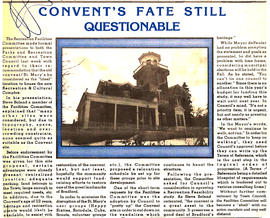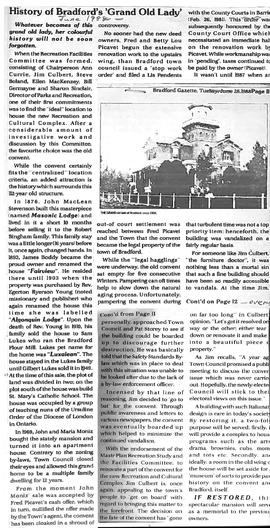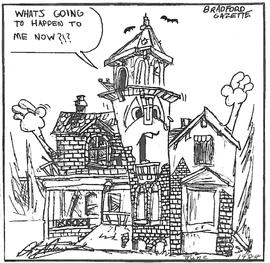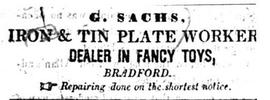The Grand Old Dame of Bradford
It's been a convent and home for the rich in the past 111 years.
It stands like a grand old lady on Bradford's main street, its ancient facade belonging to a bygone era.
But time has chipped the regal bearing of the building, wrinkling its paint and the once shiny windows that surveyed a street filled with horses and carriages are now broken and empty.
Originally a home for the town's wealthy and prominent, the 1876 mansion was also used as a convent and as an apartment building.
The building was stripped of the last vestiges of stateliness in the last five years when the Town of Bradford and its owners were embroiled in a legal controversy over ownership.
Plagued by Vandals
Left in limbo, the house was plagued by vandals and disuse. It was then that Bradford resident Jim Culbert launched his one-man crusade to have the home returned to its former glory.
The town council wanted to tear the house down to make way for a library, but now as the dispute with owner Fred Picavet is settled and the town takes possession under a new council, the future of The Old Convent is once again up in the air.
While Mayor Bill DePeuter says it isn't economically feasible to retain the complete house, he plans to hold a public meeting for residents' input into the building's fate.
But 36-year-old Culbert insists the town landmark should be preserved intact and renovated "as a tribute to those men and women who gave us our historical heritage."
He spent many an hour in libraries and registry offices and spoke to past owners in an effort to trace the heritage of the historic house.
The building is steeped in the town's history, back in 1871 when John and Eliza Armstrong sold their three-acre parcel of land bound by Letitia, Barrie and Moore streets to John MacLean Stevenson for $1,200.
Stevenson wanted a unique design for his dream house and on returning from a trip to Scotland, the Bradford lawyer brought back plans based for a Scottish castle.
At that time, English aristocrats, and later the wealthy in Ontario, were copying the design of Queen Victoria's and Prince Albert's country retreat on the Isle of Wight.
It soon became apparent to curious onlookers that the home under construction in 1876 was to emulate this popular Italianate style.
Topping the majestic home was a widow's walk or Italian campanile, an octagonal tower with windows on each side that provided a breathtaking view of Bradford and the surrounding countryside.
Inside the house, an enormous, graceful staircase spirals upwards, from the large foyer. The cherrywood that it is made of borders doors and windows throughout the house.
Off the entrance lies the formal living room with its three large windows, separated by pockets doors from a games room with oak panels, fireplace mantel and broad ceiling beams.
Beautiful Interior
A mahogany fireplace and large picture window grace the music room at the front, connected by an arched doorway to the sun room.
The back of the mansion houses the large dining room and kitchen with wainscotted walls. Behind the kitchen lies a storage room for food and meat curing. Stairways lead to the basement and second floor.
On the second floor, a distinctively etched window once separated the stair landing from the hallway, but was recently smashed by vandals. That window was the sole source of natural light for the hallway.
The upstairs landing and hallway floors are made of oak with intricate designs. Three bedrooms, two bathrooms and a dressing room complete the second floor.
Another spiral staircase leads up to the tower landing and widow's walk from where the climber can see the lake to the northeast, Newmarket to the southeast, the marsh to the south and Bradford to the north.
It is this that Culbert is fighting to keep from becoming a memory, lost in the name of progress.
The dignified house was resided in by Stevenson, the reeve until 1877. Later that year it was sold to Robert Bingham for $5,500.
Seventeen years later, Robert's widow Caroline sold the home for $2,000 during a depression. James Boddy, the reeve from 1894 to 1896, took over the house, calling it Fairview.
The deed passed through several hands until famed Canadian missionary and author Rev. Egerton R. Young of Bradford bought the house for $2,300 in 1903.
Renamed Algonquin Lodge, the minister made it his home shortly after marrying one of Bradford's most attractive ladies, Libbie Bingham. After his death in 1910, the house was again sold, going to Samuel Lukes for $3,600.
Renovations
The Lukes family, which operated the busy Bradford Flour Mill on Holland Street, made several repairs to their house, replacing the verandas with one large one.
In 1929, Samuel's son Gilbert continued alterations, adding a sun room, changing the location of the driveway and entrance steps as well as stuccoing the home for warmth.
Artie Saint. the town's popular house and barn builder, was commissioned to do the renovations, converting a bedroom into a dressing room and building the unique bathroom with bidet, shower, bath and toilet that still stands today. A garage and stable were added to the rear of the house.
Lukes began selling off parcels of land surrounding the house in 1945, and in 1949, a For Sale sign went up again on the front lawn of what was then called Luxalean.
The Roman Catholic Episcopal Corporation for the Diocese of Toronto bought the house for $19,000 but soon sold it to the Ursuline Order of the Diocese of London, a group of teaching nuns.
However, the plot of land south to the house was retained and St. Mary's Catholic School was built.
The stately mansion passed through on era of grandeur and spacious living, the huge terraced gardens becoming a concrete driveway and then in 1969, it was converted into an apartment house by John and Maria Moniz.
Despite town bylaws prohibiting such use, it was used as a multiple family dwelling for 12 years until 1981 when the 105-year-old building was sold to Fred and Betty-Lou Picavet for $90,000.
The Picavets hoped to restore the house but had only stripped plaster from the inner and outer walls, in tending to insulate for a warm and comfortable home, when they were halted by a certificate of lis pendents filed by the town in February, 1981.
The town had issued a stop-work order and Picavets in turn sued the town.
Mayor DePeuter said although the town had offered to buy the house and placed a deposit, the Picavets stepped in with the cash.
An agreement was reached this month, ending the lawsuits, and the town will purchase the house from the Picavets.
The mayor said council will discuss ways that the building can be used by residents, adding the neighbouring old St. Mary's school is well-used as a nursery school and community meeting hall.
While DePeuter says he realizes some residents will want the building retained for historical reasons, he feels it would cost too much. Instead, certain parts such as the facade or tower could be kept, he adds.
Community Uses
The dispute over ownership was of little concern to Culbert, a self-admitted antique lover and owner of The Furniture Doctor. He only wishes to see the house restored without the loss of its original character.
Culbert says the house could have a number of community uses, adding if elevators were installed, it would make a beautiful library.
He estimated the 111-year-old house would need about $250,000 in repairs including new plumbing, drywall, insulation and doors and windows.
"It may be in disrepair but it's never sagged," he says. "It still is standing."
The mayor says council isn't in a hurry to make a decision about the building but will likely decide its fate by the end of the year.
Until then, like any grand old lady, the house patiently waits, accepting the ravages of time and age with stoicism while memories dance inside.
This newspaper article is from the Bradford Womens Institute Scrapbooks.







